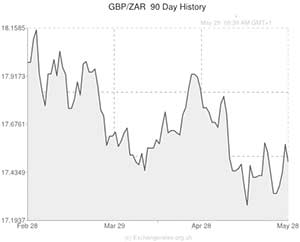
Before the publication of South Africa’s producer price index the Rand was in a stronger position against the Pound but weaker against the US Dollar.
While the Rand was able to hold its own against Sterling, the emerging-market asset was close to a multi-week low against the US Dollar as a result of a risk-off environment and ongoing domestic concerns.
The Rand broadly softened in response to this week’s less-than-impressive South African growth report and is still feeling the effects of the news.
The over four-month long strike in South Africa’s platinum mining sector is also having an impact.
As the tension in Ukraine intensifies once more, investors are turning to lower-risk assets to the detriment of currencies like the Rand.
According to recent reports Russia has urged that emergency measures be introduced in order to bring an end to the violence in eastern Ukraine. Russia’s Foreign Minister Sergei Lavrov was quoted as saying; ‘It’s necessary to take emergency steps to stop the bloodshed and start an inclusive internal Ukrainian dialogue.’
However, the Pound remained weaker against the Rand as investors deemed Sterling’s advance excessive and fixated on this week’s disappointing UK reports.
Earlier in the week UK mortgage approvals were shown to have declined unexpectedly while yesterday’s CBI reported sales data showed a slowing in national retail sales growth. Both reports contributed to the reduced appeal of the Pound.
On Thursday Sterling consolidated declines against its major rivals as the result of a drop in the Lloyd’s business barometer.
The measure slid to 41 in May from 66 the previous month.
While the GBP/ZAR pairing was little changed following the release of South Africa’s producer price index, the USD/ZAR exchange rate maintained a stronger position.
The report showed that headline producer inflation in South Africa increased by more-than-anticipated in April, climbing to an annual figure of 8.8 per cent from 8.2 per cent the previous month.
Economists had expected a reading of 8.4 per cent.
On the month producer price inflation increased by 1 per cent in April following the 1.3 per cent rise in March.
A gain of 0.7 per cent had been expected.
Later today significant USD/ZAR fluctuations could occur in response to US growth data for the first quarter.
If the initial estimate of annualised 0.1 per cent growth is negatively revised to contraction of 0.5 per cent (as has been forecast) the Rand could recoup losses against the US Dollar.
Investors will also be taking an interest in tomorrow’s South African private sector credit and balance of trade figures.
South African Rand (ZAR) Exchange Rates
[table width=”100%” colwidth=”50|50|50|50|50″ colalign=”left|left|left|left|left”]
Currency, ,Currency,Rate ,
Pound Sterling, ,South African Rand,17.4517,
,South African Rand,17.4517,
Euro, ,South African Rand,14.1889,
,South African Rand,14.1889,
US Dollar, ,South African Rand,10.4210,
,South African Rand,10.4210,
Australian Dollar, ,South African Rand,9.6880,
,South African Rand,9.6880,
New Zealand Dollar, ,South African Rand,8.8074,
,South African Rand,8.8074,
Canadian Dollar, ,South African Rand,9.6576,
,South African Rand,9.6576,
[/table]

Comments are closed.